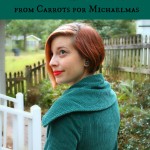Welcome to Carrots! I'm so glad you're here. This is where I share thoughts on liturgical living, faith, parenting, culture, and an extra dose of Jane Austen. You can sign up for my email newsletter here to stay in touch, or look me up on Instagram!

Since I’m bursting at the seams to start watching the new season of Downton Abbey, I thought I’d repost a wonderful guest post today from my dear friend (and new mama!) Katherine Grimm Bowers, children’s literature expert extraordinaire. It combines two of my very favorite things: Edwardian Children’s Lit and Dame Maggie Smith. Enjoy! – Haley
I’ve been watching a lot of Downton Abbey, lately, and I also wrote my undergrad thesis on Anne of Green Gables, so early twentieth-century children’s books hold a special place in my heart. And with Lady Violet’s sly children’s lit allusion in Series Two, quipping witheringly, “Edith, you’re a lady, not Toad of Toad Hall!” I feel all the more justified to associate the two in my mind.
The Edwardian era was a short reign that followed on the heels of the long Victorian period, lasting from 1901 to 1910, during the time the Grantham girls would have been growing up. Among children’s literature scholars (oh yes, there is such a thing!), it’s considered the Golden Age of children’s literature. These titles, on the whole, could easily have been on the sisters’ nursery shelves before the Downton Abbey story unfolds in April 1912.
Bernand Shaw claimed that Peter Pan was “really a play for grown-up people; for as you know, when we buy toys for children we take care to select the ones which amuse ourselves.” In this spirit, I offer up a few books for children most likely to amuse ourselves:
- The Wind in the Willows (1908). Well, we know at least Granny Grantham digs it. Another famous fan: C.S. Lewis, who famously turned to it whenever he caught cold. (Bonus: If you’re a fan of Narnia, you’ll definitely see influences.)
- Peter Pan (1902). If you’ve only seen the movie(s), you simply have to give this one a go. I know Haley’s particularly partial to the Jim Dale audio version.
- Anne of Green Gables (1908). A colonial interloper makes the list! OK, so I don’t know if the sisters would have had access to a Canadian novel, but I think we’ll all agree that Sybil’s optimism and idealism make her a total Anne.
- The Secret Garden (1911). Oh, man. I don’t even know if I can explain this. An ancient Yorkshire manor comes alive when impetuous Mary Lennox comes to stay. (I’m thinking we all know another quite contrary Mary, too.)
- The Railway Children (1906). E. Nesbit wrote 40 books for children in the course of the first two decades of the twentieth century. This one is a favorite of mine: a story of three children who live beside a railroad and make various friends while their father is accused of a crime he did not commit.
- Arthur Rackham’s editions of various Victorian classics. Rackham produces really lovely illustrations; the above is from his 1909 edition of the Grimms’ fairy tales.
- The Princess and the Goblin (1872). Earlier than the rest, but exemplifying the return to fairy tales and magic in Edwardian fiction. Another big influence on our main man, Mr. C.S. Lewis.
- A Little Princess (1911). If this book were by anyone but Frances Hodgson Burnett, it would make it on the list, no deliberation needed. Instead, I hesitate, because while I don’t love it like The Secret Garden, it’s completely wonderful in its own right. Virtue rewarded and a dash of magic. Sigh.
- Treasure Island (1882). Let’s not neglect boy books here. Though, like The Princess and the Goblin, another Victorian interloper, the Museum of Childhood assures me that Victorian favorites would have lived on upon the bookshelves of Edwardian children.
- The Tale of Peter Rabbit (1902), or anything Beatrix Potter, really. They celebrate the kind of country life Lord Grantham values.
Also, though it falls in roughly this time period, The Wizard of Oz (1900) is the pits. Seriously. Don’t bother.
When not musing on Edwardian children’s lit Katherine Bowers blogs about her adventures with an outdoorsy husband and bouncy dog at shouting hallelujah and as a librarian-type at The Cardigan Librarian.




Okay, I just have to say, Edwardian is kind of a subjective time period. It generally is understood that it lasted right until World War I(about 1914). I love this post though! Edwardian is my favorite period for children’s literature too! And pretty much anything else Edwardian.
Little Lord Fauntleroy
Wow! Love the list–but I totally disagree on the critique of The Wizard of Oz–I read the entire series in middle school & loved them!
I love this list because 3 of my grandparents were born in the Edwardian era. It is fun to think of what they might have read, and I didn’t realize so many great books were published then.
One of my grandmothers did give us a reprint of a book from her childhood, and it was full of awful stories to scare kids into being good. Like a man with giant scissors who would come cut off your thumbs if you sucked them! I can’t even imagine any bookstore carrying it now.
I would add The Wolves of Willowby Chase, but it was published in 1962! The setting fits though! So Downton Abbey.